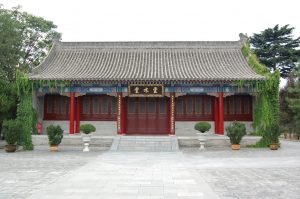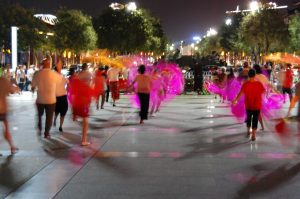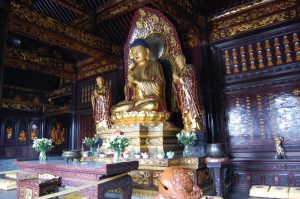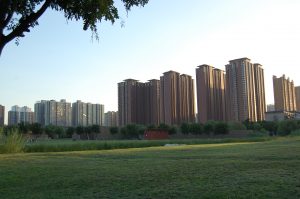The weather in Xi´an is milder with temperature around 26°C. Daylight last until 8 pm like Chengdu. Ideal condition for sightseeing and shopping until late night as most shops open until 10 pm.

Temple at Big Wild Goose Pagoda
The following day Dayan Pagoda, the Big Wild Goose Pagoda, is on my visiting list. Built in 652 as part of the Da Ci’en Temple complex and supervised by Xuanzang, the Buddhist monk who travelled the Silk road to India from 629 to 645 to study Buddhism and bringing back Buddhist texts in Sanskrit.
After returning to China and with support from the Emperor Taizong Xuanzang became the first abbot of Daci’en Temple and soon commenced to translate the Sanskrit texts into Chinese. This lifework forms the basic literature and enables the expansion of Buddhism in East and Southeast Asia to present day. Also, it makes possible to recover lost Indian sutras from the translated Chinese copies subsequently.

North square: Dayan Pagoda is currently fully covered for renovation but illuminated at night
One of the functions of Dayan Pagoda is the storage of sutras and figurines of Buddha brought back by Xuanzang from India and his writings. On request of the Emperor Xuanzang also completed his book “Great Tang Records on the Western Regions” which has become one of the primary sources for the study of medieval Central Asia and India.

South square: Exercise and dancing place for locals and tourists
Not only interesting for Buddhists but also for those who have read “Journey to the West”, including myself and nearly every Chinese, a novel inspired by the pilgrimage of Xuanzang and written nine century later by Wu Cheng´en. It belongs to the Four Great Classical Novels of Chinese literature.
Accompanied by disciples Sun Wukong, the Monkey King, Zhu Wuneng, Pigsy, and Sha Wujing, Sandy, together with a dragon prince who acts as Xuanzang’s steed, a white horse, Xuanzang´s travel is beset with adventures and full of mystic magical stories. The novel also gives an insight into Chinese folk religion, Chinese mythology, Taoist and Buddhist philosophy.



